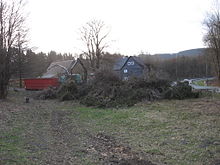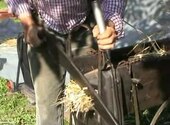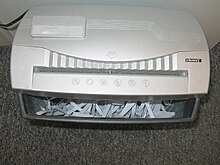Shredder (machine)
A shredder (English shredder or as Anglizismus eingedeutscht Shredder ), also hacker or chopper called, is a mechanical device for crushing various materials. It is usually used to shred bulky, large- volume waste (e.g. waste wood, old cars, plastic containers) and to reduce its volume.
In most cases, the principle of the shredder is based on a grinder driven by relatively powerful electric or combustion engines . This can consist of a gear set up by offset rollers , a beater disk or a hammer mill . When an object is put into the shredder, it is broken up into small pieces by rubbing, grinding, tearing, smashing or cutting it up. The result is called shredded material , in the case of biomass, in particular wood, also wood chips or wood chips .
use
Shredding of coarse waste
Shredders are used for shredding bulky waste in the unloading halls of waste incineration plants and are often used in scrap recycling , e.g. B. in car recycling companies . First, the old cars are “cannibalized”, operating materials are drained and parts containing precious metals ( cable harnesses , car radios and catalytic converters ) are dismantled and sorted out. The body shell is first pressed and then cut into small, fist-sized parts using a hammer mill. Depending on their mass, the parts are thrown out to different extents and thus separated, and magnetizable metals are separated by means of electromagnets . This enables the disposal company to sort the residual materials as accurately as possible for subsequent recycling .
A distinction must be made between two fundamentally different forms of shredder: While classic shredders smash the inputted metal according to the hammer-and-anvil principle, systems for shredding large metal parts give the metal a quick blow. By using drive units with an output of more than 3500 HP, large structural steels can now also be shredded using the hammer-and-anvil principle.
Shredder for shredding garden waste
Gartenschnittgut of trees, shrubs and perennials stalks, hedge clippings and other biogenic bulky garden waste, occasionally coarse compost , hay , Huftierdung , tree bark, turf , Jätgut , potted plants , including root ball, Torfstücke , fall foliage , fall apples and grass clippings can be using a garden shredder (sometimes "Chipper "Called") into fine, quickly compostable pieces. The chopped material is then used as mulch or mixed into the compost as a structural material or mixed directly into the humus as “organic fertilizer” . Chopped branches, twigs and weed residues are usually unable to erupt or continue to grow . Part-time farmers also use small garden shredders to chop up fodder beets , corn stalks , sunflower stalks and straw for cattle feed production.
Garden shredders are available in different designs and performance levels, which are used depending on the type and amount of clippings. They are mostly driven by electric motors (alternating current with 230 volts or three-phase alternating current ) or petrol engines (for mobile use), only large devices are powered by tractors with a connection to the PTO shaft . In principle, there is no limit to the branch diameter. The thicker the clippings, the more powerful the motors have to be. Allotment garden shredders are designed for branches up to 4.5 cm thick. If there are thicker branches in the allotment garden, they are often sawn into firewood .
For professional use there is the bush chopper , which is usually equipped with feed rollers that automatically pull in the clippings that have been filled in, and with an emergency shut-off bar. Chopper with more powerful drives usually have a high ejection, in which the chopped material is thrown away in a high arc (so that it can fall directly onto a tractor trailer, for example). With shredders for the home garden (in which more attention is paid to "cleanliness"), the shredded material usually falls down or into a container. In the case of containers made of translucent material, it is possible to assess whether the container is full. A backlog of the chopped material can cause blockages.
Branches stuck in the filling funnel can sometimes - if they are caught by the rotating knives - whip like a whip, which is why the manufacturers usually recommend wearing protective gloves and goggles when chopping.
Blockages or blockages can be removed either by switching the direction of rotation or, more laboriously, by opening the housing. Especially low-wood and moist waste (turf, green stalks of herbaceous plants , grass remnants, etc.) can easily cause blockages of the discharge opening.
"Second generation" garden shredders have a high filler neck with an attached funnel, so that replenishing cannot lead to contact of the hands with the knives. In the case of self-retracting shredders, the feed opening is matched to the maximum branch thickness and replenishing plungers are included, which intervenes is prevented. Modern professional large choppers with self-retraction have emergency shut-off bars that switch off the drive and block the cutting unit as soon as pressure is exerted on the hopper edge. The dangers that need to be prevented in models with self-retraction are usually that bulky branches, thorns or spikes can get caught in work gloves or items of clothing and then exert a surprisingly fast pull in the direction of the cutting unit.
The following shredding techniques are used for allotment garden use:
- Garden shredder with knife cutting unit on a plate-shaped knife disc - the oldest technology. A flywheel fitted with knives cuts the material to be chopped into small pieces, an additional knife ring in the middle (similar to a stand mixer ) chops thin twigs, leaves and stems into smaller pieces . Devices with a metal funnel are usually very noisy, and the manufacturers recommend hearing protection for work . Bulky waste usually has to be replenished, which is time-consuming and laborious. If a lot of dried old wood or hardwood is shredded, the knives can quickly become blunt. Some models have reversible blades that can be remounted.
- Shredders with a cone- shaped flywheel (with what is known as a “ cone-head cutter ”) or if the flywheel is inclined represent an improvement . As a result, the chopped material is drawn in automatically, provided it is in contact with sufficiently sharp knife discs.
- Garden shredders with a roller cutter automatically pull in the waste and are significantly quieter than shredders with a knife cutter . The cuttings are usually also squeezed and thus fray. They work slower than other types, but while they are moving in, more waste can be picked up and fed to the chopper, which means less time is needed for refilling. Particularly massive waste (thin branches with thick leaves, branches with dense needles) and delicate stalks of green waste are difficult to pull through the narrow intake openings by the rollers. The roller gears (star-shaped in cross-section) then cut off parts without pulling them further, contact with the teeth is lost, the self-retraction no longer works, which leads to blockages.
- Garden shredders for semi-professional use (for the occasional chopping of bulky tree and shrub cuttings) have a self-feed (through a roller) and a hammer cutting mechanism like a hammer mill . The cuttings in the feed hopper are gripped by movably mounted knives, chopped up into fibers and smashed. Since the movable knives push through stones, they are not as prone to damage, but most models have a sieve and the wood chips only leave the chopper when it is of the appropriate size.
- Newer devices on the market are garden shredders "with the ax principle". The chopping process is accomplished by chopping knives on a horizontal shaft and stable counter knives. The shredder has (similar to a washing machine ) a removable viewing window for the chopping chamber, the housing is made of compact plastic and therefore the chopping process is quiet. The self-retracting models are more suitable for large throughput quantities with only a smaller branch diameter (up to 35 mm) and produce rather coarse, fibrous wood chips.
- Garden shredders with spiral cutting units (also known as "snail choppers " ) are also represented in the retail trade, but they lead a niche existence. They are just as slow, powerful and quiet as those with a roller cutter and have an exceptionally good self-closing mechanism, but are prone to damage (e.g. from stones or branches that are too thick). Similar to the spiral-shaped intake shaft of a meat grinder , knives attached to a conical shaft screw themselves into the cut material. The system is self-retracting, but in garden shredders it is only built for small branches. The working principle has its advantages in the production of wood chips for firing purposes. The finished wood chips have uniform grain sizes with few fines, the resulting heap tends to have cavities that facilitate subsequent drying.
Dry woods are harder than freshly cut greenwood , hardwood is harder than softwood ; Artifacts (nails, stones, grains of sand in the ground, detached knives) ruin the cutting edges, and in general the cutting edges of rotating knives and any fixed counter knives that may be present wear out heavily during operation. Depending on the amount of material used and the duration of use, the cutting edges have to be resharpened regularly, blunt blades extend the time required for chopping or block the rotating parts. Material removal from the knives during chopping and sharpening usually increases the gap between knife and counter knife, then the result becomes more chunky or the cutting performance decreases. In the case of roller choppers, the cutting edges grind against the counter plate during operation, since this only needs to be adjusted using an adjusting screw. In all cases, removed knife material ends up in the wood chips.
Roller choppers usually produce rather coarse, broken-up wood chips, which are usually composted (i.e. used as structural material in compost preparation and thereby supports ventilation and aerobic decomposition processes) or as mulch for plantings that remain in place (ornamental plants). Disc, cone or hammer choppers tend to cut into smaller pieces. The wood chips are therefore preferred as mulch for alternating crops (vegetables) (because mixing with the humus is unavoidable during harvest). It is also true that choppers for high throughput tend to produce larger wood chips and fine mulch material is more likely to be produced by smaller machines.
Finished shredded material from green wood or heaps exposed to precipitation, but also mulch coverings made from it, start to mold relatively quickly, which can be a danger for people with allergies to spores and aspergillosis , but is a normal part of natural decomposition (molds are, in turn, food for other living beings, as a result, the plant nutrients stored in wood are reintroduced into nature's cycle). Therefore, the finished chopped material is usually quickly put to its intended use (mulch, composting).
The low volume of slow-running roller shredders, spiral shredders and shredders with noise-insulated plastic housings enables garden waste to be shredded even without hearing protection, at rest times and on Sundays, and can keep the peace with listening neighbors.
Chopper in traditional agriculture
In traditional agriculture, many devices were used to chop up crops. Beets were chopped up and used as fodder. Chopped up straw was mixed with the beets to make them more compatible with the cattle. Chopped up straw was also used as bedding. The video shows how a straw cutter works and how it is used.
Chopper for shredding old bread
For shredding of old bread , so-called "universal food" or "Restbrotzerkleinerer" used. They are similar in structure to garden shredders, but the discharge has sieves so that only crumbs of a defined grain size can leave the shredder. This type of shredded leftover bread is used in bread dough preparation , as breadcrumbs , animal feed or for mash preparation.
Shredders in industrial factory farming
In industrial laying hen production, shredders are used in the production process. The rooster chicks , separated according to their sex , fall from the assembly line into a funnel to be killed by rapidly rotating knives underneath. In this process, the law requires the shredder to perform a service that guarantees “immediate” killing. The corresponding machines are called "homogenizers" or "chick grinders". The resulting pulp is processed into animal feed or used in biogas plants.
Larger animal carcasses are also shredded in animal carcass disposal plants, for example so that they can be burned more easily ( landfill ) or processed further, for example into animal feed ( animal meal ). This practice massively promoted the spread of the BSE bovine disease in the 1990s.
Shredder in the kitchen drain
Sewage pumps with cutting unit
Some fecal pumps are equipped with a cutter to chop up waste that is brought into a toilet (such as sanitary towels or condoms ) that could clog the centrifugal pumps or pipes before pumping.
Shredding
Shredders for shredding files are mostly used in the office environment, especially in areas that deal with sensitive paper-based data. Shredders for document destruction work according to the following scheme: Either the inserted paper is cut into fine strips lengthways to the direction of insertion, or the imported documents are cut lengthways and crossways (cross-cut) , whereby, depending on the distance between the knives, very small fragments can arise which are practical can no longer be put together. A special form is the wet shredder, which also uses water. In the field of professional document shredders , large shredder systems are also used, in which full files can be placed, which are then torn apart by a powerful mechanical grinder. When recycling waste paper , metal parts in the paper pulp produced sink to the bottom of the container or are removed with the help of a magnet , while lighter plastic parts floating up are dragged along by an immersed, revolving chain and thus skimmed off.
Data destruction
Shredding has also become a common term for data destruction in electronic data processing (EDP) . Special computer programs - so-called erasers - are used for this purpose, which irretrievably delete files from data carriers according to defined specifications . This can e.g. B. be done by overwriting a file.
Mechanical shredders are also used to destroy discarded, written data carriers (CD-ROM, DVD, magnetic tapes, floppy disks, hard drives, etc.) together with their contents and then to recycle them according to type.
See also
Web links
Individual evidence
- ↑ Eliet Neo chopper (PDF file; 2.7 MB)
- ↑ Details on the snail chopper at uni-goettingen.de
- ^ Text of the Animal Welfare Slaughter Ordinance
- ^ Lists and camps. Retrieved April 20, 2019 .
- ↑ Archived copy ( memento of the original from June 30, 2015 in the Internet Archive ) Info: The archive link was inserted automatically and has not yet been checked. Please check the original and archive link according to the instructions and then remove this notice.








